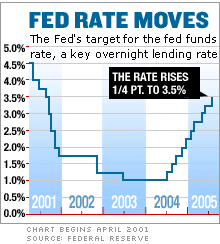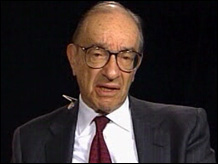 |
|
|
|
|
|
|

|
| The Federal Reserve raised the target for a key short-term interest rate by a quarter of a percentage point. (August 9) |
Play video
|
|
|
|
NEW YORK (CNN/Money) -
The Federal Reserve raised the target for a key short-term interest rate by a quarter of a percentage point for the 10th consecutive time Tuesday. The move was widely expected on Wall Street, as several recent economic reports have indicated that the economy remains relatively strong.
And like the Energizer Bunny, the Fed sent a signal that it plans to keep going and going and going with more rate hikes as it seeks to keep inflation at bay. In its eagerly anticipated statement, the nation's central bank said it would likely keep increasing rates at a "measured" pace.
That language, according to many Fed watchers, all but guarantees that the Fed's monetary-policy committee will raise rates by another quarter of a percentage point at its next meeting on September 20, and once more on November 1. So now the big question on the minds of investors is how much further will the Fed go?
Tuesday's boost leaves the federal-funds rate, which banks use to determine overnight lending rates, at 3.5 percent, its highest level in four years. Rising short-term rates should make it more expensive for consumers to borrow money, since the Fed's actions tend to lead to similar increases in credit-card rates, adjustable-rate mortgages and car loans.
Based on the Fed's statement, it appears that Fed Chairman Alan Greenspan is still keeping a close watch on inflation, but that the Fed is not overly concerned about the effect that rising oil and gas prices may have on consumers.
"Aggregate spending, despite high energy prices, appears to have strengthened since late winter," the Fed noted, adding that "core inflation has been relatively low in recent months."
The Fed also reiterated that "labor market conditions continue to improve gradually," a phrase it has used in its past several statements. Some have worried that a pickup in job and wage growth could lead to higher levels of inflation and cause the Fed to get even more aggressive with its rate hikes. Those fears came to a boil on Friday when the July jobs report was much stronger than expected.
Market braced for more hikes
But investors took the Fed's announcement in stride. Stocks, which were trading modestly higher before the announcement, held on to their gains following the release of the statement. Bonds rose slightly, sending the yield on the benchmark 10-year U.S. Treasury down from 4.43 percent to 4.38 percent. (Bond yields and prices move in opposite directions.)
"The market's reaction is a testament to how effective the Fed's strategy has been in telegraphing its interest-rate moves," said Vincent Boberski, chief fixed-income strategist with RBC Dain Rauscher.
Boberski added that based on what the Fed said about core inflation and energy prices, it seems certain that the Fed won't consider ending its series of rate hikes until December at the earliest.
"They are obviously making the case to tighten," Boberski said. "There is no justification to speed up or slow down. We will end the year with rates at 4 percent or 4.25 percent. It depends on whether the Fed wants to take one meeting to pause and assess where the economy is going."
John Norris, chief economist with Morgan Asset Management, agreed that the Fed is unlikely to stop raising rates any time soon. What's more, he said the Fed's admission that inflation is not a major problem indicates that Greenspan and other Fed members are not just worried about pricing pressures in the economy. Norris thinks the Fed is likely to keep raising rates in order to shake out what some consider to be speculative froth in the bond and housing markets that has been fueled by relatively low long-term rates.
"The Fed is tipping their hat to say they are not focusing just on inflation but easy access to money," Norris said. "Inflation gauges are not showing much, but monetary policy may be too loose, so the Fed could continue to tighten the screws until the economy shows signs of slowing down." With this in mind, Norris also believes that the fed-funds rate will be either 4 percent or 4.25 percent by the end of this year.
Chip Hanlon, president of Delta Global Advisors, an investment advisory firm in Huntington Beach, Calif., said he's also concerned about a potential housing bubble. To that end, he thinks the Fed has more room to raise rates. In fact, he said the Fed should have boosted rates by 50 basis points, or a half of a percentage point, on Tuesday to really shock bond investors and get long-term rates to move higher.
"It seems clear that the housing market is on the mind of Fed officials," he said. "Sloppy lending has led to excesses in the real-estate market." Hanlon added that the recent increases in the prices of oil, in addition to rising prices of gold and the boost in wages, are legitimate signs that the threat of inflation is a reasonable justification to keep raising rates.
But could the Fed go too far with its rate hikes? Some worry that continued tightening will lead to more than just a slowdown.
"It looks like we will have quarter of a point increases for the rest of our natural lives or the next recession, whichever comes first. The Fed has not shown an ability to engineer a soft landing," said Barry Ritholtz, chief market strategist with Maxim Group, a New York-based money-management firm. As such, Ritholtz believes the Fed will keep raising rates for the remainder of the year, but by early 2006, it might need to start cutting interest rates to jump-start the economy again.
For a look at bond rates, click here.
For more special coverage about the Fed, click here.

|